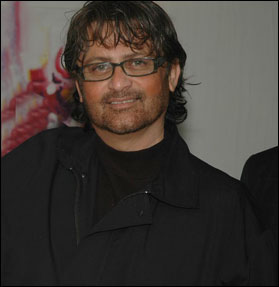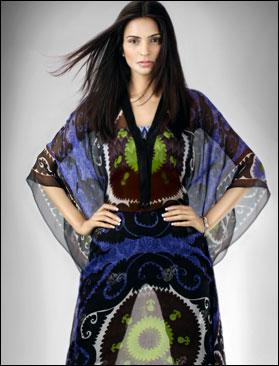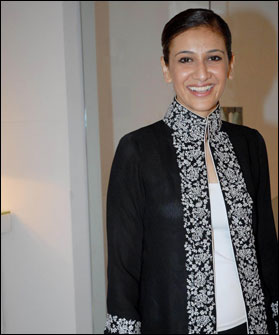|
|
| |
instep
overview
Fashion and the fabric
Designers have been leasing their signatures out to textile manufacturers
for many years but the business has become so profitable that every
other person is eager to jump onto the lawn bandwagon now. Yet not
everyone designing lawn prints can be called a designer, not unless
they have creative control over the finished product. And that product
– ready-to-wear lawn clothing – is the fashion revolution
that Pakistan eagerly awaits.
By Aamna Haider Isani |
| |
|
It's the end of April, a time when designers all
over the world are wrapping up post fashion week business and are
figuring out the logistics of meeting deadlines and fulfilling orders
for fall/winter 2008. They are busy working on fashion forecasts
and trends for the next season already. In Pakistan, it's a time
when fashion swings into a totally opposite direction. Instead of
seasonal collections and trends in ready to wear clothing, it is
lawn that makes it to the limelight. Instead of prêt a porter,
it is lawn that establishes a link between fashion and the masses
and consequently, everyone begins obsessing about it. This year,
the obsession has been unprecedented and has gone into such an overdrive
that everyone under the sun wants to jump onto the lawn bandwagon
and make hay while the sun shines. The hay, of course, being the
huge profits that come with operating on mass scale and in Pakistan
nothing gets more massive than lawn sales.
|
 |
| |
| This
year has seen the maximum number of fashion designers lending their
label to textile manufacturers. Rizwan Beyg, Sana Safinaz, Sara Shahid,
Maria B and even Sobia Nazir are already established names in the
fashion industry. For them, lawn is the link that connects them with
the masses. What these designers create in their studios and sell
for hundreds of thousands of rupees stays within high society. But
when they create lawn, they suddenly become a household name and their
profile steps into every nook and cranny of the country. Needless
to say, the money textile mills invest in getting these prestigious
labels on their fabric is also quite lucrative for the designers.
The consumer, on the other end of the equation, feels as if he is
actually wearing a piece of Rizwan Beyg or Sana Safinaz, otherwise
unaffordable. It's a mutually beneficial situation for the mill, the
designer and the buyer alike. They all go home happy. |
| |
|
But as with fashion,
fabric has also become a bandwagon that is attracting everyone to
step up onto it. Once upon a time it was a bored housewife who would
get a tailor and a karighar into her garage and insist on being
called a 'fashion designer'. Now that bored housewife has given
up on fashion and sees greater profits in simply being a 'lawn designer'.
It's a definite way of becoming successful overnight, even if only
in print! Quite simply, it's a better and definitely more profitable
business venture. But it's not just the bored housewife. This lawn
pie has suddenly gotten so rich that everyone wants a slice of it.
Be it supermodel Vaneeza Ahmad, photographers Guddoo and Shani or
socialites Mahin and Erum, anyone with resources and contacts is
getting into the lawn business. The most amazing thing is that every
yard sells because the market is huge enough to accommodate everyone.
But the fact that models, photographers and socialites are designing
lawn does not make them fashion designers. They are textile designers
at best, that too if they have absolute creative control of the
prints that go under their label.
|
 |
| |
Fashion
is a term that directly equates to the final image of a garment, it
dictates a trend and it forecasts a certain style. Simply put, it
has a vision of how a certain fabric should fall on a woman's body.
Fabric alone cannot predict that vision because the final product
is dependent on every single woman who will take those five yards
of fabric home and rearrange them to their creative capability.
What needs to be appreciated at this cross road is the effort certain
designers are making to make Pakistan's most popular fabric fashionable.
Rizwan Beyg has started experimenting with lawn; he has created ball
gowns, voluminous shalwars and impeccably structured trousers with
the fabric. If he were to sell his vision - which he intends to do
soon - it would go like hot cakes.
Sana Safinaz admit that though they consider styling lawn equivalent
to 'tailoring it' - something they don't have time for right now -
the prints they stylize and put in the catalogues (distributed at
the exhibitions) are the ones that attract most attention. Women come
for their vision of how lawn should be put together this season. |
| |
|
|
Sara Shahid is currently
designing prints on chiffon and lightweight silks, but she is another
designer who deserves applause for her treatment of fabric. This
year she took out a limited edition of prints but then she lent
them her signature and put them together as separates, sold at her
store. She believes that the prints and the way they have been designed
reflect her style ethos and are an extension of her aesthetic. That
is what one can readily call fashion.
Designers are pushing the boundaries of fashion designing and they
are also dictating the creativity of prints. As Rizwan Beyg says,
it wouldn't be challenging at all if everyone was sketching prints
that were going into linear printing. For him lawn printing has
become a creative challenge in which he, as a designer, wants to
play around with the neckline and the hemline via the print. He
says that mills are seriously investing time and money into the
vision designers are bringing to the textile industry and that is
pushing forward the most "viable prêt" available
in Pakistan.
|
 |
| |
People
like Vaneeza Ahmed (V Lawn) or Shehryar Sumar (V9 Lawn) may not be
designers themselves but they are roping designers into the equation.
Vinny gets designer friends Umar Sayeed, Nomi Ansari and Maheen Kardar
amongst others to give her fabric a fashionable silhouette. The printed
outfit she wears to her own exhibition gets sold out first. A style
icon herself, one eagerly awaits for her first collection of ready
to wear lawn. Shehryar Sumar on the other hand, has taken on the role
of promoting new and upcoming designers on this profitable platform.
This year he has brought Fahad Hussayn and Tara Mehmood on board;
he intends to open up the business for many more.
Yahsir Waheed, one of the pioneers of 'designer lawn collections'
confesses that it won't be simple getting into ready to wear. He has
been successfully catering to the lawn market for ten years now and
is hoping to shift gears to lawn prêt soon. He is optimistic,
especially since he says menswear has already made its mark. That,
according to him was the first step and though designing ready to
wear clothing for women is not going to be simple, it is the next
step forward.
With their Ideas retail stores, textile giants Gul Ahmad are already
taking those steps forward. They have been experimenting with unstitched
separates - embroidered white shalwars, embellished kurtis etc - for
quite some time and this year they have launched the G-man line of
menswear too.
Can womenswear be far behind? This is the long awaited and somewhat
inevitable collaboration between fashion and textile mills. Sure enough,
whenever it happens, it will be a strong foot forward for both. |
| |
|

